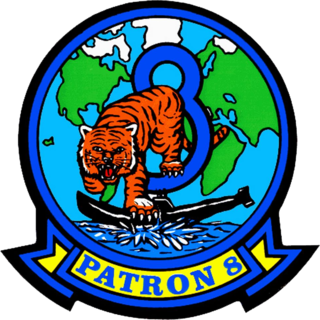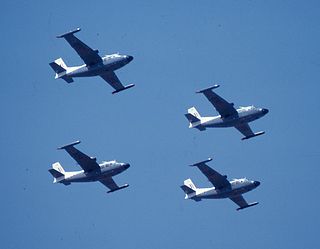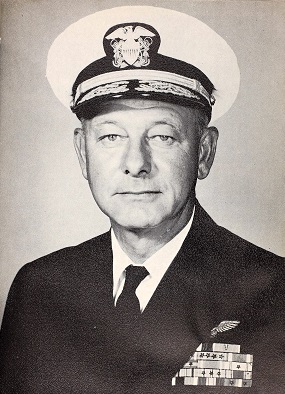
The Vought OS2U Kingfisher is an American catapult-launched observation floatplane. It was a compact mid-wing monoplane, with a large central float and small stabilizing floats. Performance was modest because of its low-powered engine. The OS2U could also operate on fixed, wheeled, taildragger landing gear.

Glynn Robert Donaho, nicknamed "Donc", was a United States Navy officer known principally for his exploits as a submarine commander during World War II, for which he received the Navy Cross four times, the Silver Star twice, and the Bronze Star Medal.

Submarine Squadron 4 was raised by the United States Navy in 1930. Since 9 July 1997, the squadron has been based at the Naval Submarine Base New London, Groton, Connecticut, United States of America.

Naval Station Norfolk Chambers Field (IATA: NGU, ICAO: KNGU, FAA LID: NGU),or LP-1/Chambers Field, is commonly known simply as, Chambers Field, and is named after Captain Washington Irving Chambers. It is a military airport in Norfolk, Virginia that is a part of Naval Station Norfolk. It supports naval air forces in the United States Fleet Forces Command, those operating in the Atlantic Ocean, Mediterranean Sea, and Indian Ocean. It's important to note that, "Chambers Field" only refers to the geographical area of the airport runway, taxiways, two heliports and six helipads.

Patrol Squadron Eight (VP-8) is a U.S. Navy land-based patrol squadron stationed at Naval Air Station Jacksonville, Florida (USA). VP-8 is tasked to undertake maritime patrol, anti-submarine warfare (ASW), and intelligence, surveillance and reconnaissance (ISR) missions. The Squadron is equipped with the Boeing P-8A Poseidon.
Ro-34 was a Kaichū type submarine of the K6 sub-class built for the Imperial Japanese Navy. Completed and commissioned in May 1937, she served in World War II, operating in the South China Sea and the Netherlands East Indies, off New Guinea, and in the Solomon Islands. She was sunk in April 1943 during her eleventh war patrol.
I-74, later I-174, was an Imperial Japanese Navy Kaidai type cruiser submarine of the KD6B sub-class commissioned in 1938. During World War II, she took part in the attack on Pearl Harbor, the Battle of Midway, the Guadalcanal campaign, the New Guinea campaign, and the Gilbert and Marshall Islands campaign and operated off Australia before she was sunk during her ninth war patrol in 1944.

27 Squadron was established as a World War II maritime patrol squadron of the South African Air Force. It was disbanded after the war and resurrected in the same role from 1951 to 1958. Its final period of service was from 1962 to 1990 when it was finally disbanded when its Piaggio Albatross aircraft were de-commissioned.

880 Naval Air Squadron was a Royal Navy Fleet Air Arm aircraft carrier-based squadron formed in January 1941. The squadron served throughout the Second World War being embarked in the carriers HMS Furious, Indomitable, Argus and Implacable serving off East Africa, in the Mediterranean, off Norway and in the Far East. It was disbanded on 11 September 1945 at Schofields, Sydney, Australia.

Commander James Wiggins "Red" Coe (missing), January 8, 1946 was an American submariner. A submarine ace, Coe commanded USS Skipjack and Cisco during operations in the Pacific theatre of World War II. After a number of successful patrols, Coe and the Cisco failed to return from patrol in November 1943, and her captain and crew were presumed dead in 1946.

USS PC-552 was a class-461 patrol craft ("PC") that was at the forefront of the naval efforts during the Normandy invasion. It served as convoy protection in the North Atlantic and as one of about ten PC control vessels off Omaha Beach during the Normandy invasion. PC-552 was among the first ships to reach waters off Omaha Beach. PC-552, primary control vessel for Fox Green sector of the beach, was forced into rescue efforts and recovery of bodies at the departure line for Fox Green when the Duplex Drive tanks that survived the initial disastrous launch were swamped at the line with only two surviving. The PC was diverted into this effort for forty-five minutes and ultimately only five tanks, the two that survived the launch disaster and three that were aboard LCT-600 whose commander raised his ramp when the first off foundered and instead landed them on the beach, reached the beach.
VP-44 was a Patrol Squadron of the U.S. Navy. It was established as VP-204 on 15 October 1942, redesignated as Patrol Bombing Squadron VPB-204 on 1 October 1944, redesignated as VP-204 on 15 May 1946, redesignated as VP-MS-4 on 15 November 1946, redesignated as VP-44 on 1 September 1948 and disestablished on 20 January 1950. It was the third squadron to be assigned the VP-44 designation. The first VP-44 had that designation from 1 July 1940 to 6 January 1941. The second VP-44 had that designation from 3 June 1941 to 1 October 1944. A fourth VP-44 was established on 29 January 1951 and disestablished on 28 June 1991.
VP-27 was a Patrol Squadron of the U.S. Navy. The squadron was established as Patrol Squadron 83 (VP-83) on 15 September 1941, redesignated Bombing Squadron 107 (VB-107) on 15 May 1943, redesignated Patrol Bombing Squadron 107 (VPB-107) on 1 October 1944, redesignated Patrol Squadron 107 (VP-107) on 15 May 1946, redesignated Heavy Patrol Squadron (Landplane) 7 (VP-HL-7) on 15 November 1946, redesignated Patrol Squadron 27 (VP-27) on 1 September 1948 and disestablished on 11 January 1950.

RADM Edward Cobb Outlaw was a naval aviator, flying ace, ship's captain and fleet commander of the United States Navy. Outlaw first served as commanding officer of Fighting Squadron 32 (VF-32) aboard the light carrier USS Langley during World War II. He was awarded the Navy Cross for a mission with this squadron in which he shot down five Japanese planes, making him an ace in a day.

Willard Arthur Saunders was a highly decorated submarine commander in the United States Navy during World War II and later Rear Admiral. A graduate of the Naval Academy, he distinguished himself as Commanding Officer of the submarine Grayback on war patrols in early 1942; he was decorated with the Navy Cross, the United States' second-highest decoration awarded for valor in combat.
I-69, later I-169, was an Imperial Japanese Navy Kaidai-class cruiser submarine of the KD6 sub-class commissioned in 1935. She served in World War II, during which she conducted six war patrols and took part in operations supporting the attack on Pearl Harbor, the Battle of Midway, the Guadalcanal campaign, the Aleutians campaign, and the defense of the Gilbert Islands. She sank in a diving accident in April 1944.

I-18 was one of five Type C cruiser submarines of the C1 sub-class built for the Imperial Japanese Navy. During World War II, she operated as the mother ship for a midget submarine during the attack on Pearl Harbor and the attack of Diego-Suarez, conducted a war patrol in the Indian Ocean, and served in the Guadalcanal campaign before she was sunk in February 1943.
Ro-100 was an Imperial Japanese Navy Ro-100-class submarine. Completed and commissioned in September 1942, she served in World War II, operating in the Solomon Islands, Rabaul, and New Guinea areas. She sank in November 1943 when she struck a mine during her seventh war patrol.
Scouting Squadron 33 (VS-33) was a United States Navy anti-submarine warfare squadron in World War II.

Transition Training Squadron Atlantic was a United States Navy training squadron in World War II. It was established on 28 July 1941 upon redesigned of the Operational Training Squadron of the Atlantic Fleet. It was stationed at Naval Air Station Norfolk, Virginia, with one detachment at Naval Air Station Banana River, Florida and one detachment at Glenn L. Martin Company, Middle River, Maryland. It fell under the Commander, Naval Air Force U.S. Atlantic Fleet.













